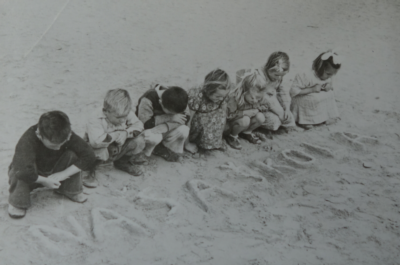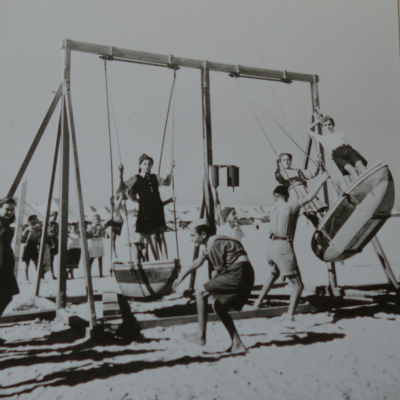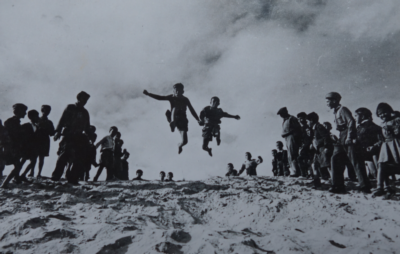Living for a Better Future in the El Shatt Refugee Camp
In January 1944, the El Shatt refugee camp was established on the Sinai Peninsula. Following the Italian capitulation in September 1943 and in anticipation of the German invasion and reprisals, approximately 30,000 people from Dalmatia (southern Croatia) found refuge in the Egyptian desert. The representatives of the Communist Party of Yugoslavia, with war victory within reach, sought to organize and motivate their future citizens just like they did at home.
As the photos below show, these activities included organizing the lives of numerous children who found refuge in El Shatt, both their school and free time activities.

Pencils and paper were scarce and as a rule reserved for older school children. The youngest, therefore, had to learn how to read and write on the sand. The image shows children posing with the sign Naša škola (Our school) written on the sand.

In their free time, children could play on the swings that the residents of this camp made from driftwood.

Free time was often organized through various group activities, such as the athletics competition shown on the image.
You can hear more about life in El Shatt refugee camp on the WARFUN podcast here.
Photographs: UNRRA, UN Archives, Middle East – Social Life and Customs, S-0800-0008-0010
Further reading:
Bieber, Florian. “Building Yugoslavia in the Sand? Dalmatian Refugees in Egypt, 1944-1946.” Slavic Review 79, no. 2 (Summer 2020): 298-322.
Burić, Eli, “Zabilješke iz zbjega u El Shattu” [“Notes from the El Shatt Refuge”]. Kulturni radnik 8, no. 3-4 (1955): 108-111.
Nola, Danica. “Pionirsko kazalište El Shatt” [“Pioneer Theatre El Shatt”]. In Kultura i umjetnost u NOB-u i socijalističkoj revoluciji u Hrvatskoj [Culture and Art in the NOB and Socialist Revolution in Croatia], edited by Ivan Jelić, Dunja Rihtman-Auguštin, Vice Zaninović, 427-431. Zagreb: Institut za historiju radničkog pokreta Hrvatske, 1975.
